 W
WDayaram Jethamal Sindh Government Science College, commonly known as DJ Science College, is a public community college that is affiliated with the University of Karachi — it is located near Burns Road in Karachi, Sindh, Pakistan.
 W
WDarya Lal Mandir or Darya Lal Sankat Mochan Mandir is a Hindu temple in Karachi, Pakistan. It is located near Custom House, Saddar Town in the Sindh Province of Pakistan. It is a 300 year old temple. The temple is dedicated to Darya Lal (Jhulelal),who is considered as incarnation of Varuna Deva
 W
WDenso Hall, officially The Max Denso Hall and Library, is a library located in Karachi, Pakistan. It was built in 1886 as the first library in Karachi to serve the native population.
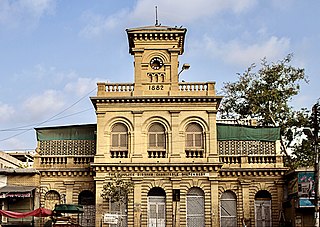 W
WEdulji Dinshaw Dispensary, officially the Eduljee Dinshaw Charitable Dispensary, is a building in the Saddar neighborhood of central Karachi, Pakistan. It was built in 1882, and served as a charitable dispensary for Karachi's citizens. It was named after Karachi-based Parsi philanthropist Seth Edulji Dinshaw, who donated 5,500 rupees towards construction - half of the building's cost. Dinshaw had risen from poverty and became the largest landowner in Karachi at the time. It was designed James Strachan, and was Karachi's first Italianate building.
 W
WEdward House is a building which is located in the Civil Lines area of Karachi, Pakistan It was designed by the Iraqi-Jewish architect Moses Somake in 1910, and named after Somake's son, Ellis Edward.
 W
WFreemasons Lodge Building in Karachi, Pakistan is a historic building built in 1914, during British rule, situated near D.J. Sindh Govt. Science College at Molana Din Muhammad Wafai Road.
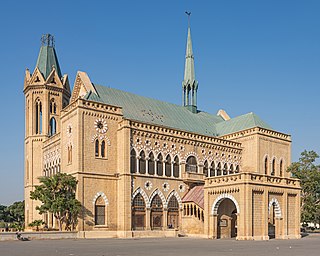 W
WFrere Hall is a building in Karachi, Pakistan that dates from the early British colonial era in Sindh. Completed in 1865, Frere Hall was originally intended to serve as Karachi's town hall, and now serves as an exhibition space and library.
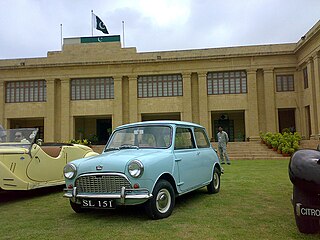 W
WThe Governor's House in Karachi, Sindh, Pakistan is the official residence of the Governor of Sindh. The current Governor of Sindh is Imran Ismail. It is located along the Aiwan-e-Sadar Road of Karachi.
 W
WThe Hindu Gymkhana is a colonial-era building located on Sarwar Shaheed Road in Karachi, Pakistan. It was the first public building in Karachi to adopt the Mughal-Revival architectural style. It was established in 1925 by the Karachi's Hindus as an exclusive club for their community. From 2005 to 2020, it still houses the National Academy of Performing Arts.
 W
WHoly Trinity Cathedral is the seat of the Church of Pakistan, Diocese of Karachi, situated on Fatima Jinnah Road, near Zainab Market, in Karachi, Pakistan.
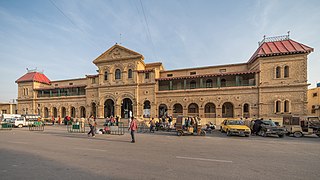 W
WKarachi Cantonment Railway Station is one of the principal railway stations in Karachi, Sindh, Pakistan. It is situated near Dr. Daudpota Road, Saddar.
 W
WThe Karachi Chamber of Commerce and Industry Building, also known as the KCCI Building, is a heritage building in central Karachi, Pakistan dating from 1934. Its foundation stone was laid by Gandhi in July 1934. It currently serves as headquarters for the Karachi Chamber of Commerce & Industry.
 W
WThe Karachi Metropolitan Corporation (KMC) Building is a colonial-era building located on M. A. Jinnah Road, in central Karachi. Construction began in 1927, completed in 1930, and the building was then inaugurated in 1932. It is considered to be one of the most architecturally significant buildings in Karachi.
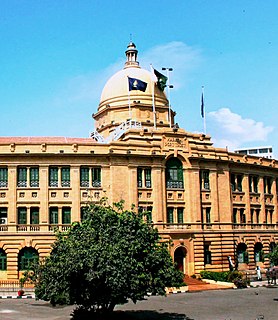 W
WThe Karachi Port Trust Building, also referred to as the KPT Building, is a large colonial-era building in Karachi, Pakistan that serves as headquarters for the Karachi Port Trust, which administers the Port of Karachi. The building dates from the height of the British Raj, and was inaugurated on 5 January 1916.
 W
WKhaliq Dina Hall, also spelled Khaliq Deena Hall, is a library and hall located in Karachi, Pakistan. The building was built in 1906, and was after Ghulam Hoosain Khalikdina - a wealthy merchant and philanthropist who was the main financier for the building, and who wished for Karachi's Muslims to have a space for literary pursuits. It currently has a hall which is used for various events, a library, and a room that serves as the office of a local NGO.
 W
WLakshmi Building is located in Karachi, Sindh, Pakistan. It is located at the intersection of Muhammad Ali Jinnah Road and Aiwan-e-Tijarat Road in Karachi's Mithadar district. Built in 1938, the Lakshmi Building was Karachi's tallest building at the time of Pakistan's independence and thereafter until it was surpassed in 1955 by Qamar House in the adjacent neighborhood of Kharadar.
 W
WKarachi is a tourist destination for domestic and international tourists. This is a list of tourist attractions in the city of Karachi, Sindh, Pakistan.
 W
WThe Manora Point Lighthouse is an active lighthouse located in Manora, Karachi, on the Arabian Sea in Pakistan, where it is fourth tallest lighthouse in the country at a height of 38 m (125 ft). The lighthouse was first established on the point in 1851, being second oldest light station in the former British Indian Empire.
 W
WMazar-e-Quaid, also known as Jinnah Mausoleum or the National Mausoleum, is the final resting place of Quaid-e-Azam Muhammad Ali Jinnah, the founder of Pakistan. Designed in a 1960s modernist style, it was completed in 1971, and is an iconic symbol of Karachi as well as one of the most popular tourist sites in the city. The mausoleum complex also contains the tomb of Jinnah's sister, Māder-e Millat Fatima Jinnah, as well as those of Liaquat Ali Khan and Nurul Amin, the first and eighth Prime Ministers of Pakistan respectively. The tomb of Sardar Abdur Rab Nishtar, a stalwart of the Muslim League from Peshawar, is also located there.
 W
WMerewether Clock Tower or Merewether Tower is a neo-Gothic clocktower built during the Victorian era in Karachi, Pakistan. The tower is a landmark in central Karachi, and is at the termini of two of the most important roads in central Karachi: Muhammad Ali Jinnah Road and I. I. Chundrigar Road. The tower used to mark the boundary of the city when arriving from the port at Kiamari, and marked the dividing line between Karachi's Old Town and its newer European quarters to the east. It currently is the westernmost point of the Serai Quarter.
 W
WThe Mohatta Palace is a museum located in Karachi, Sindh, Pakistan. Designed by Agha Ahmed Hussain, the palace was built in 1927 in the posh seaside locale of Clifton as the summer home of Shivratan Mohatta, a Hindu Marwari businessman from what is now the modern-day Indian state of Rajasthan. The palace was built in the tradition of stone palaces of Rajasthan, using pink Jodhpur stone in combination with the local yellow stone from nearby Gizri. Mohatta could enjoy this building for only about two decades before the partition of India, after which he left Karachi for the new state of India.
 W
WPamwal Das Shiv Mandir at Pawaldass compound at Kakri Ground in Baghdadi area of Lyari Town. According to the Human Rights Commission of Pakistan and The News International Muslim clerics have illegally turned this centuries-old historic temple into a Muslim pir and slaughterhouse for cows with the help of Baghdadi police after making series of attacks on Hindu families living in the area.
 W
WShri Panchmukhi Hanuman Mandir is a historic Hindu temple in Pakistan. It is located in the Soldier Bazaar in Karachi in the Sindh Province of Pakistan It is a 1,500 year old temple. It is the only temple in the world that has the natural statue of Lord Hanuman. It is declared as a national heritage under the Sindh Cultural Heritage (Preservation) Act 1994.
 W
WThe Quaid-e-Azam House, also known as Flagstaff House, is a museum dedicated to the personal life of Muhammad Ali Jinnah, the founder of Pakistan. Located in Karachi, Sindh, Pakistan, it was designed by British architect Moses Somake.
 W
WThe Rama Pir Mandir is a Hindu temple dedicated to Ramdev Pir in Tando Allahyar in Sindh, Pakistan. The annual Ramapir Mela festival is the second largest Hindu pilgrimage in Pakistan, after the annual Hinglaj yatra which is the largest Hindu pilgrimage in Pakistan
 W
WRatneshwar Mahadev Temple is a historic underground Hindu temple in Karachi, Pakistan. It is located near the Clifton Beach in Clifton. The temple is famous for its annual Shivratri celebration, and during religious celebrations, around 25,000 pilgrims visit the temple.
 W
WShri Laxmi Narayan Mandir is a Hindu temple located in Karachi, Pakistan. According to the Pakistan Hindu Council, the temple was constructed around 200 years ago and is an important worshiping site for the Hindus of the local community. The Mandir is one of the oldest operating temples and the only one situated at the banks of a creek in Karachi.
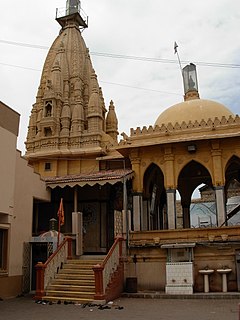 W
WThe Shri Swaminarayan Mandir, Karachi is a Hindu temple that is the only Swaminarayan temple in Pakistan. The temple is notable for its size and frontage, over 32,306 square yards (27,012 m2) on the M. A. Jinnah Road in Karachi city. The temple celebrated its anniversary of 216 years in April 2004. It is believed that not only Hindus but also adherents of Islam visit the temple, which adds to its notability. There is a sacred cowshed within the premises of this temple. The temple is located at the centre of a Hindu neighbourhood in Karachi. The building that housed a dharmshala for visiting devotees has now been converted to the office of the City District Government.
 W
WThe TDF Ghar is an informal learning space situated in Karachi, Pakistan. It’s a house constructed in the 1930s and restored as a living museum. The Dawood Foundation (TDF) has retained the heritage architectural features of the house to preserve the living style of the past residents of cosmopolitan Karachi.
 W
WVictoria Museum, now called Supreme Court Registry, Karachi, founded as Victoria and Albert Museum, is a building in Karachi which houses Supreme Court of Pakistan Karachi registry branch.
 W
WWazir Mansion known officially as Quaid-i-Azam Birthplace Museum is a former family home in the Kharadar district of Karachi, Sindh, Pakistan which is considered the birthplace of the country's founder, Muhammad Ali Jinnah.